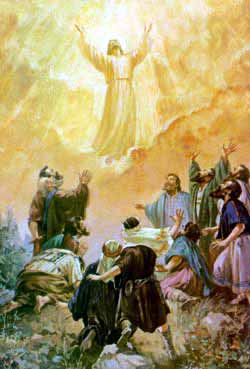 All four New Testament gospels tell about Jesus being crucified, dying on the cross, being entombed, and then rising from the dead on the third day. (The expression, “after three days,” in Mark is a Semitic idiom meaning “third day” in other synoptics). Then all four of these gospels relate various narratives about the risen Jesus appearing to his disciples the following days. He conversed with them, ate and drank with them, and they even literally touched him. Ghosts can’t eat and drink or be touched.
All four New Testament gospels tell about Jesus being crucified, dying on the cross, being entombed, and then rising from the dead on the third day. (The expression, “after three days,” in Mark is a Semitic idiom meaning “third day” in other synoptics). Then all four of these gospels relate various narratives about the risen Jesus appearing to his disciples the following days. He conversed with them, ate and drank with them, and they even literally touched him. Ghosts can’t eat and drink or be touched.
Luke says regarding Jesus’ disciples, “he presented himself alive to them by many convincing proofs, appearing to them during forty days and speaking about the kingdom of God” (Acts 1.3 NRSV and throughout). Then Luke relates that upon Mount Olivet, “they were watching, he was lifted up, and a cloud took him out of their sight. While he was going and they were gazing up toward heaven, suddenly two men in white robes stood by them. They said ‘Men of Galilee, why do you stand looking upward toward heaven? This Jesus, who has been taken up from you into heaven, will come in the same way as you saw him go into heaven'” (vv. 9-11).
Many Bible readers have questioned what form the risen Jesus had when he appeared to his disciples after his resurrection. Did he have a body like his previous body? Or was it somehow different? In some of the either ten or eleven resurrection appearances recorded in these four NT gospels, the risen Jesus instantly appeared and disappeared, even in a room or rooms in which the door was closed if not locked. This phenomena in itself suggests that Jesus’ resurrection body was of a different sort than his previous, physical body. Plus, the Apostle Paul later says the risen Jesus had “a spiritual body.” He explains concerning the human body its later resurrection, “It is sown a physical body, it is raised a spiritual body. If there is a physical body, there is also a spiritual body” (1 Corinthians 15.44).
Luke also tells one episode that occurred only hours after Jesus was resurrected. Luke says two disciples were walking to Emmaus, apparently a town a seven miles from Jerusalem. They were discussing the news about Jesus’ purported resurrection that Sunday morning (Luke 24.13-14). Luke continues, “While they were talking and discussing, Jesus himself came near and went with them, but their eyes were kept from recognizing him” (vv. 15-16). He then engaged them in conversation. They arrived at their destination and invited Jesus to eat with them. Luke says, “he took bread, blessed and broke it, and gave it to them. Then their eyes were opened, and they recognized him; and he vanished from their sight” (vv. 30-31). Luke says they then returned to Jerusalem and told it to the other disciples (vv. 33-34).
So, Luke 24 says the risen Jesus appeared to two disciples and they did not recognize him. It was not because he looked strange, but because of something that had been done to them, i.e., their eyes.
The same may have happened to Mary Magdalene when she first saw the risen Jesus the second time she visited the tomb that morning. For the Fourth Evangelist relates, “But Mary stood weeping outside the tomb. As she wept, she bent over to look into the tomb; and she saw two angels in white, sitting where the body of Jesus had been lying, one at the head and the other at the feet. They said to her, ‘Woman, why are you weeping?’ She said to them, ‘They have taken away my Lord, and I do not know where they have laid him.’ When she had said this, she turned around and saw Jesus standing there, but she did not know that it was Jesus. Jesus said to her, ‘Woman, why are you weeping? Whom are you looking for?’ Supposing him to be the gardener, she said to him, ‘Sir, if you have carried him away, tell me where you have laid him, and I will take him away.’ Jesus said to her, ‘Mary!’ She turned and said to him in Hebrew, ‘Rabbouni!’ (which means Teacher)” (John 20.11-16). Now, Mary’s eyesight may have been blurred from crying, so that she did not see properly, but her initial failure to see that it was Jesus could have been due to God preventing her eyes from seeing properly as occurred with the two men walking to Emmaus.
However, Mark 16.9-10 tells a slightly different story. It says the risen Jesus appeared to Mary Magdalene. She reported it to the disciples, but they did not believe it. Then Mark says of Jesus, “After this he appeared in another form to two of them, as they were walking into the country. And they went back and told the rest” (vv. 12-13). This report obviously refers to the same incident Luke reports in Luke 24.13-35. Yet this brief, Markan report says the risen Jesus appeared in “a different form” (Gr. etera morphe), whereas Luke’s much fuller account says of these two disciples, “their eyes were kept from recognizing him.” Is this not a contradiction? If so, can we trust the Bible?
This account of Jesus’ appearing to the two disciples on the road to Emmaus is an example of why modern Bible readers should be careful to read Bible footnotes or columnar references. Most modern English Bibles explain that the Greek manuscript evidence for the ending of the Gospel of Mark is in question. That is, Mark ends at Mark 16.8 or it has some additional verses. There are two main variants which scholars call the Short Ending and Long Ending. The Short Ending reads, “All that had been commanded them they told briefly to those around Peter. And afterward Jesus himself sent out through them, from east to west, the sacred and imperishable proclamation of eternal salvation.” And the Long Ending is Mark 16.9-20, which appears in most Bibles. There are other variants for the ending of Mark in the Greek manuscript evidence, but these are the main ones.
It is textual-critical scholars who spend their lives studying the Greek manuscripts of the New Testament and therefore put together the Greek New Testament. The two main Greek New Testaments, from which modern English Bibles are translated, are the United Bible Societies 4th edition of the Greek New Testament and Nestle’s 27th edition of the Greek New Testament. Both of these Greek New Testaments indicate that the long reading of Mark 16.9-20 is questionable as to whether or not it was part of the original Gospel of Mark. And most modern English Bibles mention this in a footnote or a columnar reference.
These scholars have many reasons for concluding that Mark 16.9-20 probably was not part of the original Gospel of Mark. Difference in style and vocabulary are some. I think this difference between Luke and Mark about the two disciples on the road to Emmaus is another. That is, these two accounts of it are in disagreement. It is much more likely that Luke provides the correct account, that the two disciples could not recognize the risen Jesus because something had happened to their eyes that prevented them from doing so, not that he appeared in a different form as the questionable Mark 16.9 says.
Still, what kind of body did the resurrected Jesus have? To answer this, I think it best for Bible believers to try to lay aside speculation and only rely on certainties as revealed in scripture.
First, Jesus’ body certainly was immortal, since both Old and New Testaments attest to this concerning the future resurrection of the dead. Jesus, as Paul explains, is the first fruits of that yet future resurrection of all of God’s deceased people (1 Corinthians 15.20-23).
Second, Jesus’ resurrection body must have been a reformation of his dead physical body. We know this because the women discovered that Jesus’ body was missing, and the angels explained that it was because Jesus had risen from the dead (Matt. 28.2-6; Mark 16.5-6; Luke 24.2-9, 22-23; John 20.11-16). But what of the difference in gospel accounts, in which two say two angels/men appeared, and the other two gospels say it was one angel. The correct answer must be the same as with the different reporting about the number of women who went to the tomb that morning. It was two angels (who appeared as men), but probably one of them did the recorded speaking. And there were multiple women, but John only mentions Mary because of his sole account about her encountering Jesus.
Third, the risen Jesus could appear and disappear instantly and even in locked rooms.
Fourth, the risen Jesus ate and drank in the presence of his disciples (Luke 24.42-43; Acts 10.41; John 21.12-13). And they even touched him (1 John 1.1; cf. Luke 24.39; John 20.27).
Beyond these biblical statements about Jesus’ resurrection body, we ought not speculate. It was a spiritual body, as Paul says; yet the risen Jesus could speak, eat food, be touched, and bear the marks of the nail prints in his hands/wrists and feet.













